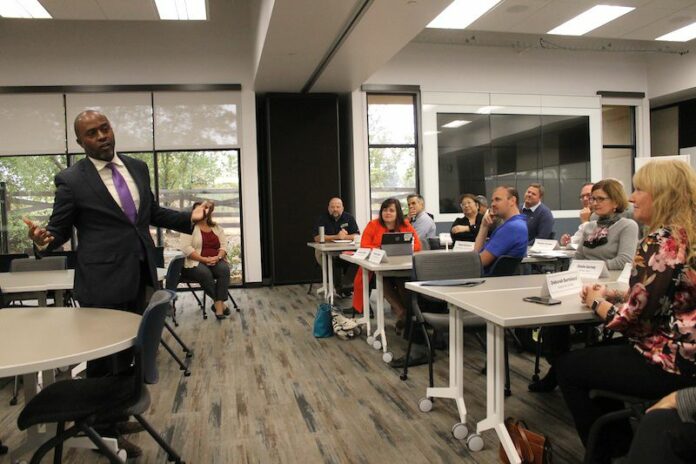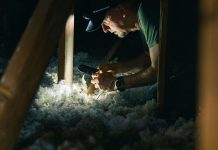While the Kincade Fire did not damage the number of homes that the 2017’s fires did, its impacts were felt more directly on north county, with the communities of Windsor, Healdsburg and Geyserville being completely evacuated as the fire approached.
Schools had already been closed in those three areas due to the public safety power shutoffs (PSPS) prior to the evacuations, but the superintendents of those districts are now facing a mountain of challenges post-fire, from damage to their physical structures to damage to the psyches of their students and staff.
We sat down with Brandon Krueger, the Superintendent of the Windsor Unified School District, Superintendent Chris Vanden Heuvel of the Healdsburg Unified School District and Deborah Bertolucci of the Geyserville Unified School District, along with Sonoma County Superintendent of Schools Steve Herrington, to hear how things were going for them. They had just participated in a workshop of sorts with other Sonoma County superintendents and state superintendent of schools Tony Thurmond.
Geyserville in the crosshairs
Geyserville was the district most directly impacted by the fires and was both evacuated first and remained closed the longest. When we spoke with Bertolucci her campus had not opened yet, but did reopen on Nov. 12.
“My site is not passing inspections yet, I’m still trying to get things up and running so hopefully today,” she said on Nov. 8. “We finally got gas on yesterday and our water — we’ve got well water so we’re trying to get that to pass inspection — I got notified about that yesterday afternoon that that was good. We have a lot of damaged branches that could potentially hurt students, so we’re trying to get a tree service in to help with that.”
The fires burned all around and in some places through the campus, and though no buildings were destroyed the process of bringing them back to a standard adequate to reopen has proven challenging.
“Our buildings weren’t being cleaned to a standard where they were allowing us to reopen, so they’re re-shampooing carpets, and I had to fight for that, they weren’t going to do that for us. I tried to explain that we had fires burning around our buildings on our campus and thankfully they saved our buildings but there is quite extensive smoke damage,” she said.
Though she has benchmarks for things like air and water quality she must meet, she’s been flying blind on some other issues.
“I don’t know what to do about the burned grounds. Nobody is giving me guidelines on that. I’m assuming it was not hazardous right there, it just burned grass all around,” she said.
All in all, Geyserville students were out of class for three weeks by the time they returned on Nov. 12.
Navigating re-entry
When kids returned to classes at Healdsburg and Windsor (on Nov. 6 and Nov. 7 respectively, following extensive cleanup and smoke damage restoration of both districts’ sites) both districts had to figure out how to support their students, staff and families through the emotional upheavals as well as the practical damages they were facing.
“We actually utilized (SCOE-available) crisis counselors who came back on (Monday, Nov. 4) and did a day of professional development with our teachers and the instructional staff, just to help them, starting with self care,” Krueger said. “We are all going through a very traumatic event, so how do we come back together, making sure we take care of ourselves so we can take care of our students.”
Kruger said part of the day was dedicated to a workshop and a chance for individual school sites to break out and start planning what they were going to do and discuss the use of trauma-informed practices and the things to be looking out for among the affected.
“One of the things we’re focusing on now as far as getting back on track is trying not to be too academically focused,” Krueger said. “The reality is we have to feel out the situation as we go along, so yesterday and today were about bringing our community back together and making our kids feel safe and that we feel safe with ourselves and our own mental well being so we aren’t caught unawares.
“One of our schools has actually looked at their curriculum and their pacing guides and their maps and they’re redrawing everything that they’re doing and they’re restructuring them,” Krueger continued. “We don’t want this to be a catch-up on everything we lost for two weeks. We want this to be a reset and a logical and comfortable getting back into the rigor of the curriculum, but it’s not being forced.”
“I can tell you that getting schools open, getting that sense of normalcy is very important for trauma,” Herrington said. “Getting the school back open is one the necessary components to get kids to deal with it and able to get into the situation and move on.”
“Unfortunately, we know how to do this,” Vanden Heuvel said to vigorous agreement from his colleagues. “We did similar to what Brandon (Krueger) did, we brought staff back before the kids because we need to not only take care of our kids and families, we need to take care of our staff as well, so we give them time to debrief and share and rebuild community a little bit.”
Healdsburg had already started work on becoming a trauma-informed district this year, and already had specialists from the Hanna Institute under contract.
“They were able to come in and help guide staff, give staff some information on how to deal with the students coming back and then they were around to help with the kids also,” Vanden Heuvel said. “We anticipate that there will be more. What we’re hearing from our experts is that it takes time. Right now were just kind of getting back in the groove and restoring our routine to normal and right now normal feels good but the stress and reality is going to hit down the road so it’s important to feel poised and ready in those situations.
“This time around for us, versus the Tubbs, the students are a lot more affected,” he continued. “So sharing and then taking advantage of things — for instance we had an area in the elementary school where they could go with music or color or a variety of things they could do if they felt they needed to remove themselves.”
SCOE also has a wealth of information for parents and educators on helping children manage trauma, available at scoe.org/pub/htdocs/safe-schools.html.
“Most of this information is built off of the Tubbs Fire, like how to talk to your child about trauma,” Herrington said.
Next steps
In the coming weeks and months each district will have to contend with displacements of staff and students, including losses and gains. Though it’s early still, the districts are already learning about changes ahead.
In Windsor, Krueger said they have gained four new families in the district, who lost their homes elsewhere due to the fires, and in addition they know of three families who lost their homes or suffered severe damage.
In Healdsburg, four staff members either lost their homes or had significant smoke damage to contend with. As of press time, staff were still determining the number of affected students, though Vanden Heuvel had confirmed at least one family lost their home.
In Geyserville, they’ve confirmed five families in the district lost their homes, though a significant number, around 80, were displaced and it’s still unknown how that might affect future numbers.
“The town has been repopulating, but we’ve been helping feed people,” Bertolucci said. “World Kitchen was phenomenal. (I came) back into town and then just threw my stuff in my house so I could go and prepare to receive families. Corazon Healdsburg was there handing out clothing. Our families were very heavily impacted in Geyserville. It was great to see the outpouring of support I was really grateful for that. I was trying to not just open the campus (for classes) but we also had food distribution. What I’ve been experiencing this time around is the we’ve been that hub of support.”









